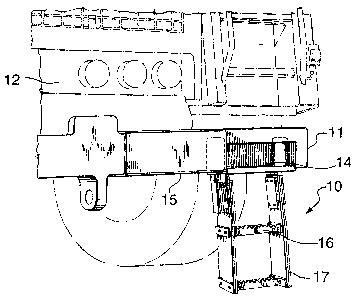Some of the information on this Web page has been provided by external sources. The Government of Canada is not responsible for the accuracy, reliability or currency of the information supplied by external sources. Users wishing to rely upon this information should consult directly with the source of the information. Content provided by external sources is not subject to official languages, privacy and accessibility requirements.
Any discrepancies in the text and image of the Claims and Abstract are due to differing posting times. Text of the Claims and Abstract are posted:
| (12) Patent: | (11) CA 2178023 |
|---|---|
| (54) English Title: | FLEXIBLE STEP ASSEMBLY FOR VEHICLES |
| (54) French Title: | SYSTEME DE MARCHES SOUPLES POUR VEHICULES |
| Status: | Term Expired - Post Grant Beyond Limit |
| (51) International Patent Classification (IPC): |
|
|---|---|
| (72) Inventors : |
|
| (73) Owners : |
|
| (71) Applicants : |
|
| (74) Agent: | ROSEANN B. CALDWELLCALDWELL, ROSEANN B. |
| (74) Associate agent: | |
| (45) Issued: | 2006-03-21 |
| (22) Filed Date: | 1996-06-03 |
| (41) Open to Public Inspection: | 1997-12-04 |
| Examination requested: | 2003-05-15 |
| Availability of licence: | N/A |
| Dedicated to the Public: | N/A |
| (25) Language of filing: | English |
| Patent Cooperation Treaty (PCT): | No |
|---|
| (30) Application Priority Data: | None |
|---|
This invention relates to a flexible step assembly for vehicles, which includes a number of vertically disposed horizontal steel tread members attached at their ends to flexible side members. A spring loaded assembly is attached to the upper ends of each side member, the spring loaded assembly is of two part construction, top part being fixed to a location on the vehicle for use, the lower part being separable under impact from the top part, but upon release of loading, recoupled by a spring and its associated components.
La présente invention concerne un ensemble de marchepied souple pour véhicules comprenant un certain nombre d'éléments de giron en acier disposés horizontalement et rattachés en leurs extrémités à des éléments latéraux souples. Un ensemble monté sur ressort est rattaché aux extrémités supérieures de chaque élément latéral, l'ensemble monté sur ressort étant de construction en deux parties, une partie supérieure étant fixée sur un emplacement du véhicule pour être utilisée, la partie inférieure étant séparable de la partie supérieure sous l'effet d'un impact, mais, la charge cessant, celle-ci est couplée à nouveau au moyen d'un ressort et de ses composants associés.
Note: Claims are shown in the official language in which they were submitted.
Note: Descriptions are shown in the official language in which they were submitted.

2024-08-01:As part of the Next Generation Patents (NGP) transition, the Canadian Patents Database (CPD) now contains a more detailed Event History, which replicates the Event Log of our new back-office solution.
Please note that "Inactive:" events refers to events no longer in use in our new back-office solution.
For a clearer understanding of the status of the application/patent presented on this page, the site Disclaimer , as well as the definitions for Patent , Event History , Maintenance Fee and Payment History should be consulted.
| Description | Date |
|---|---|
| Inactive: Expired (new Act pat) | 2016-06-03 |
| Inactive: Adhoc Request Documented | 2009-04-06 |
| Inactive: Payment - Insufficient fee | 2009-04-06 |
| Inactive: Payment - Insufficient fee | 2009-04-06 |
| Small Entity Declaration Determined Compliant | 2009-03-16 |
| Inactive: Late MF processed | 2009-03-16 |
| Small Entity Declaration Request Received | 2009-03-16 |
| Letter Sent | 2008-06-03 |
| Grant by Issuance | 2006-03-21 |
| Inactive: Cover page published | 2006-03-20 |
| Inactive: IPC from MCD | 2006-03-12 |
| Inactive: Final fee received | 2006-01-03 |
| Pre-grant | 2006-01-03 |
| Letter Sent | 2005-12-08 |
| Notice of Allowance is Issued | 2005-12-08 |
| Notice of Allowance is Issued | 2005-12-08 |
| Inactive: IPC assigned | 2005-12-06 |
| Inactive: Approved for allowance (AFA) | 2005-11-25 |
| Amendment Received - Voluntary Amendment | 2005-11-03 |
| Inactive: S.30(2) Rules - Examiner requisition | 2005-05-03 |
| Inactive: Application prosecuted on TS as of Log entry date | 2003-12-03 |
| Inactive: Status info is complete as of Log entry date | 2003-12-03 |
| Letter Sent | 2003-06-19 |
| All Requirements for Examination Determined Compliant | 2003-05-15 |
| Request for Examination Requirements Determined Compliant | 2003-05-15 |
| Request for Examination Received | 2003-05-15 |
| Application Published (Open to Public Inspection) | 1997-12-04 |
| Small Entity Declaration Determined Compliant | 1996-06-03 |
There is no abandonment history.
The last payment was received on 2005-01-20
Note : If the full payment has not been received on or before the date indicated, a further fee may be required which may be one of the following
Patent fees are adjusted on the 1st of January every year. The amounts above are the current amounts if received by December 31 of the current year.
Please refer to the CIPO
Patent Fees
web page to see all current fee amounts.
Note: Records showing the ownership history in alphabetical order.
| Current Owners on Record |
|---|
| RANDY D. RINALDI |
| Past Owners on Record |
|---|
| None |